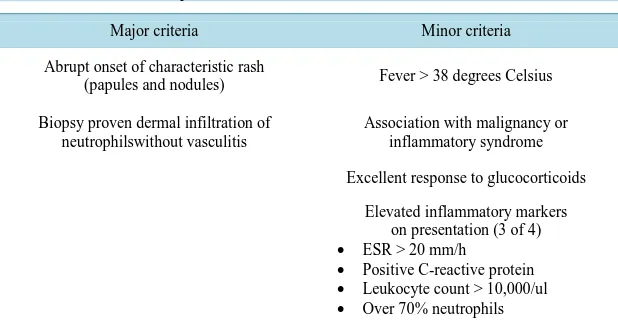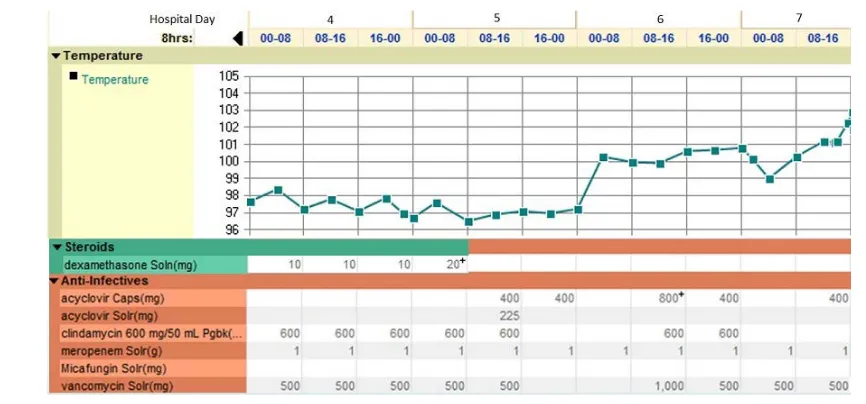http://dx.doi.org/10.4236/crcm.2016.54025
Oral Pathergy in Sweet’s Syndrome
Following Food Bolus Injury
David Klimpl, Thomas Manser, Mark Flemmer
Department of Internal Medicine, Eastern Virginia Medical School, Norfolk, USA
Received 28 February 2016; accepted 18 April 2016; published 21 April 2016
Copyright © 2016 by authors and Scientific Research Publishing Inc.
This work is licensed under the Creative Commons Attribution International License (CC BY). http://creativecommons.org/licenses/by/4.0/
Abstract
Pathergy is a unique and dramatic clinical finding of exuberant inflammation in response to local trauma. This incompletely understood phenomenon presents with sterile pustules and ulcers af-ter minor cuts or scrapes, and can be tested by a pricking the skin with a saf-terile needle. Histori-cally, pathergy was thought to be pathognomonic for Behcet’s syndrome, though it has also been described in several other inflammatory conditions such as pyoderma gangrenosum and acute fe-brile neutrophilic dermatosis (Sweet’s syndrome). Recognizing Sweet’s syndrome specifically can be challenging due to its atypical clinical course, and understanding the relationship between Sweet’s syndrome and pathergy can offer an important diagnostic clue. We present a case of Sweet’s syndrome presenting with upper airway obstruction and pathergy. To our knowledge, this is the first documented case of Sweet’s syndrome presenting with oral pathergy.
Keywords
Pathergy, Sweet’s Syndrome, Myelodysplastic Syndrome, Neutrophilic Dermatosis
1. Introduction
Table 1. Diagnostic criteria for Sweet’s syndrome. The presence of both major and two minor criteria are required.
Major criteria Minor criteria
Abrupt onset of characteristic rash
(papules and nodules) Fever > 38 degrees Celsius
Biopsy proven dermal infiltration of neutrophilswithout vasculitis
Association with malignancy or inflammatory syndrome
Excellent response to glucocorticoids
Elevated inflammatory markers on presentation (3 of 4)
• ESR > 20 mm/h
• Positive C-reactive protein
• Leukocyte count > 10,000/ul
• Over 70% neutrophils
Source: Malone et al., Arch Dermatol. 2002; 138(3): 345-349. doi:10.1001/archderm.138.3.345.
2. Case Report
A 68 years old Asian female with a past medical history of transfusion dependent myelodysplastic syndrome (MDS) presented with airway obstruction from acute oropharyngeal swelling. The patient was emergently na-sally intubated for airway protection and was therefore unable to give a history, but per her family she expe-rienced 5 days of fever, oral pain, and facial edema prior to admission. She was febrile to 39.1 degrees Celsius, tachycardic to 147 beats per minute, and mildly hypertensive to 144/87 mmHg. Physical exam showed a dif-fusely edematous oropharynx and tongue with scant hemorrhagic bullae. The remainder of her physical exam was normal. Her CBC, BMP and inflammatory markers are shown on Table 2.
CT soft tissue neck revealed a 2.7 × 1.4 × 3.8 cm mass along the R palate and R neck. Vancomycin, clinda-mycin, and meropenem were started empirically, along with IV dexamethasone 4 mg q6h. Biopsy of the oral process showed inflammation with necrosis and hemorrhage, but no neoplasia. Blood and tissue cultures were negative. An autoimmune workup was performed and was negative for lupus, mixed connective tissue disease, rheumatoid arthritis, Sjogrens, vasculitis, or hereditary angioedema [Table 3].
The patient’s swelling & fever improved and she was extubated hospital day four, and steroids were tapered off. Two days later, she developed recurrent fevers, oral pain and swelling. Repeat blood cultures were negative, and buccal biopsy staining and culture showed no bacteria, AFB, fungus, or neoplasm. Microscopy of the buccal mass tissue was again consistent only with chronic and acute hemorrhage with scattered mast cells and neutro-phils. The return of fever after discontinuation of glucocorticoids, superimposed on the continuation of antibio-tics is shown on Figure 1.
Three days after the removal of glucocorticoids, the patient developed painful erythematous plaques on her trunk and also induration of the right forearm concerning for necrotizing fasciitis [Figure 2]. Surgical explora-tion of the arm was negative for signs of infecexplora-tion, but over the course of the next 12 hours the site of surgical trauma developed a sheet of coalescent pustules consistent with a pathergy response [Figure 3]. Punch biopsy of a trunk lesion showed a superficial, thin band of neutrophils with sparing of the epidermis and intact endothe-lium of the blood vessels consistent with neutrophilic dermatitis. Sweet’s syndrome was diagnosed based on the constellation of biopsy findings, pathergy phenomenon and negative pathology and microbiology in a patient with underlying MDS. Prednisone 60 mg/d was started and within several days her fever and cutaneous lesions resolved, and she experienced dramatic global improvement. While the specific cause of the patient’s initial up-per airway obstruction is unknown, she attested to oral trauma from a food bolus the day her symptoms started. It is probable that this represented oral pathergy.
3. Discussion
Diagnosis and Treatment
Table 2. Admission complete blood count, basic metabolic panel, and inflammatory markers. The thrombocytopenia was baseline for the patient due to her MDS.
Complete blood count
WBC 4.1 × 103
RBC 3.5 × 103
HGB 9.8
HCT 28.9
Platelets <10 × 103
Segs (%) 53%
Blasts (%) 7%
Basic metabolic panel
Glucose 178 mg/dl
BUN 13 mg/dl
Creatinine 0.3 mg/dl
Sodium 138 mEq/L
Potassium 4.1 mEq/L
Chloride 106 mEq/L
CO2 21 mEq/L
Table 3. Inflammatory and autoimmune panels.
Sedimentation rate 108 mm/hr
C reactive protein 26.8 mg/dl
ANA screen Negative
DS DNA screen Negative
ENA Smith Negative
ENA RNP Negative
Rheumatoid factor Negative
SS A antibody Negative
SS B antibody Negative
C-ANCA <1:20
P-ANCA <1:20
C1 esterase inhibitor 39 (within normal limits)
C3 complement 103 (within normal limits)
[image:3.595.196.435.460.718.2]Figure 1. Return of previously treated fever with discontinuation of glucocorticoids.
Figure 2. Patient’s right arm, immediately preop.
of Sweet’s syndrome. At the time of presentation, there was no history of oral trauma, which made identifying the oral lesion a possible pathergy response diagnostically impossible. It was only after the patient developed pathergy to her surgical incision that the diagnosis became clear. With subsequent skin biopsy positive for neu-trophilic infiltrate without leukocytoclastic vasculitis, characteristic truncal rash, hematologic malignancy, fever, and resolution of symptoms with glucocorticoids, she fit both major and three out of four minor criteria for Sweet’s.
Sweet’s syndrome can present with has a variety of clinical phenomena that are not a part of its diagnostic criteria of inflammation and a papular/nodular rash. Solid organ involvement has been seen including encephali-tis [3] myocarditis, hepatitis, glomerulonephritis [4], and sterile osteomyelitis. Bullous Sweet’s [5], subcutane-ous Sweet’s, and neutrophilic dermatosis of the dorsal hands [6] are common variants that present with atypical rash patterns. Nonspecific symptoms related to systemic inflammation such as malaise and diffuse pain are also commonly reported. Pathergy is uncommonly documented in Sweet’s, but has a known association.
The pathergy response can be seen in a number of disorders, most notably Behcet’s syndrome, where an in-flammatory response to pinprick injury is part of the diagnostic criteria [7]. The response can be exuberant, and is often stimulated in response to minor or unnoticed trauma. While pathergy is not needed to diagnose Sweet’s, it can offer a crucial clue as it did in this case. A detailed literature review found one other documented case of airway obstruction caused by pathergy in Sweet’s syndrome, though in that case the inciting trauma was from a biopsy needle [8].
We chose to treat the patient with prednisone 60 mg/d. Prednisone 0.5 - 1 mg/kg/d is the standard dosing pro-tocol for Sweet’s syndrome to be continued for at least 4 - 6 weeks [9]. While colchicine and dapsone have also been shown anecdotally to be effective therapies, systemic glucocorticoids remain the gold standard. Success is assessed by rapid (<48 hours) resolution of fever and painful rash [10].
4. Conclusion
Making an initial diagnosis of Sweet’s syndrome can be difficult due to its somewhat ambiguous presentation of systemic inflammation and rash, as well as the need for a skin biopsy. Without a very high index of suspicion, diagnosis can often be delayed resulting in patient morbidity. It is important for clinicians to recognize pathergy as a sign of Sweet’s syndrome, and pursue a skin biopsy if new pathergy is observed in a patient with unex-plained systemic inflammation. This is the first documented case of Sweet’s syndrome presenting with oral pa-thergy.
Acknowledgements
Special thanks to Dr. John Snellings.
References
[1] Cohen, P.R. (2007) Sweet’s Syndrome—A Comprehensive Review of an Acute Febrile Neutrophilic Dermatosis.
Or-phanet Journal of Rare Diseases, 2, 34. http://dx.doi.org/10.1186/1750-1172-2-34
[2] Raza, S., Kirkland, R., Patel, A., Shortridge, J. and Freter, C. (2013) Insight into Sweet’s Syndrome and Associated- Malignancy: A Review of the Current Literature. International Journal of Oncology, 42, 1516-1522.
http://dx.doi.org/10.3892/ijo.2013.1874
[3] Noda, K., Okuma, Y., Fukae, J., Fujishima, K., Goto, K., Sadamasa, H., Yoshiike, T. and Mizuno, Y. (2001) Sweet’s Syndrome Associated with Encephalitis. Journal of the Neurological Sciences, 188, 95-97.
http://dx.doi.org/10.1016/S0022-510X(01)00541-X
[4] Lund, J.J., Stratman, E.J., Jose, D., Xia, L., Wilson, D. and Moizuddin, M. (2010) Drug-Induced Bullous Sweet Syn-drome with Multiple Autoimmune Features. Autoimmune Diseases, 2010, Article ID: 176749.
http://dx.doi.org/10.4061/2010/176749
[5] Voelter-Mahlknecht, S., Bauer, J., Metzler, G., Fierlbeck, G. and Rassner, G. (2005) Bullous Variant of Sweet’s Syn-drome. International Journal of Dermatology, 44, 946-947. http://dx.doi.org/10.1111/j.1365-4632.2004.02287.x [6] Walling, H.W., Snipes, C.J., Gerami, P. and Piette, W.W. (2006) The Relationship between Neutrophilic Dermatosis of
the Dorsal Hands and Sweet Syndrome: Report of 9 Cases and Comparison to Atypical Pyoderma Gangrenosum.
Arc-hives of Dermatology, 142, 57-63. http://dx.doi.org/10.1001/archderm.142.1.57
Cell Leukemia. Archives of Dermatology, 138, 1551. http://dx.doi.org/10.1001/archderm.138.12.1551
[8] Jo, T., Horio, K. and Migita, K. (2015) Sweet’s Syndrome in Patients with MDS and MEFV Mutations. New England
Journal of Medicine, 372, 686-688. http://dx.doi.org/10.1056/NEJMc1412998
[9] Sakane, T., Takeno, M., Suzuki, N. and Inaba, G. (1999) Behçet’s Disease. New England Journal of Medicine, 341, 1284-1291. http://dx.doi.org/10.1056/NEJM199910213411707
[10] Bouw, J., Kater, A., Tongeren, J. and Schultz, M. (2007) Upper-Airway Obstruction Instigated by Sweet’s Syndrome.


